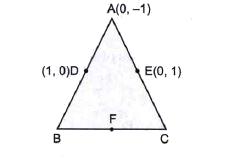Find the area of a parallelogram ABCD if three of its vertices are A(4,2),B(2+√3,5) and C(2,6)

The correct Answer is:2√3 sq.units
Topper's Solved these Questions
- COORDINATE GEOMETRYBOOK - OSWAL PUBLICATIONCHAPTER - COORDINATE GEOMETRYEXERCISE - Long ANSWER TYPE QUESTIONS
15 Videos
- COORDINATE GEOMETRYBOOK - OSWAL PUBLICATIONCHAPTER - COORDINATE GEOMETRYEXERCISE - ASSERTION AND REASONING BASED QUESTIONS
3 Videos
- COORDINATE GEOMETRYBOOK - OSWAL PUBLICATIONCHAPTER - COORDINATE GEOMETRYEXERCISE - VERY SHORT ANSWER TYPE QUESTIONS
37 Videos
- CONSTRUCTIONSBOOK - OSWAL PUBLICATIONCHAPTER - CONSTRUCTIONSEXERCISE - Assertion and Reasoning Based Questions
2 Videos
- DIKSHA QUESTIONS BOOK - OSWAL PUBLICATIONCHAPTER - DIKSHA QUESTIONS EXERCISE - UNIT -VII: Statistics and Probability (Probability) (Long Answer Type Questions )
12 Videos
Similar Questions
Knowledge Check
The fourth vertex D of a parallelogram ABCD whose three vertices are A(−2,3), B(6,7) and C(8,3)is
A(0,1)B(0,−1)C(−1,0)D(1,0)
Find the possible pairs of co-ordinates of the fourth vertex D of the parallelogram, if three of its vertices are A(5,6),B(1,2)andC(3,−2)
View SolutionThe fourth vertex D of a parallelogram ABCD whose three vertices are A (-2,3), B (6,7) and C (8,3) is
View SolutionFind the area of quadrilateral ABCD, the co-ordinates of whose vertices are A(1, 2), B(6, 2), C(5, 3) and D(3,4).
View SolutionThe three vertices of a parallelogram ABCD taken in order are A(3, -4), B(-1, -3) and C(-6, 2). Find the coordinates of the fourth vertex D.
View SolutionThe three vertices of a parallelogram ABCD taken in order are A(3, -4), B(-1, -3) and C(-6, 2). Find the coordinates of the fourth vertex D.
View SolutionThree vertices of a parallelogram ABCD taken in order are A (3, 6), B (5, 10) and C (3, 2) find :
(i) the coordinates of the fourth vertex D.
View SolutionThree vertices of a parallelogram ABCD taken in order are A (3, 6), B (5, 10) and C (3, 2) find :
(ii) length of diagonal BD.
View Solution
